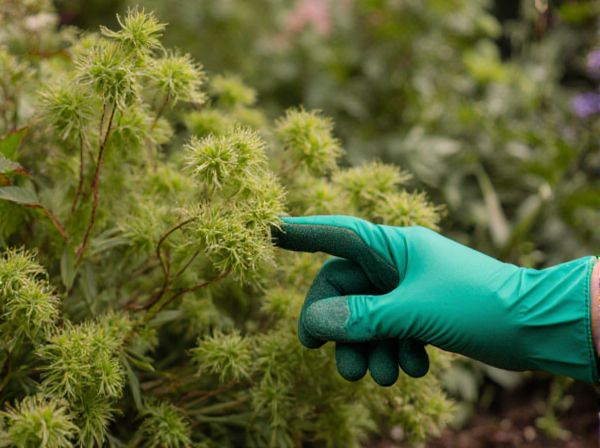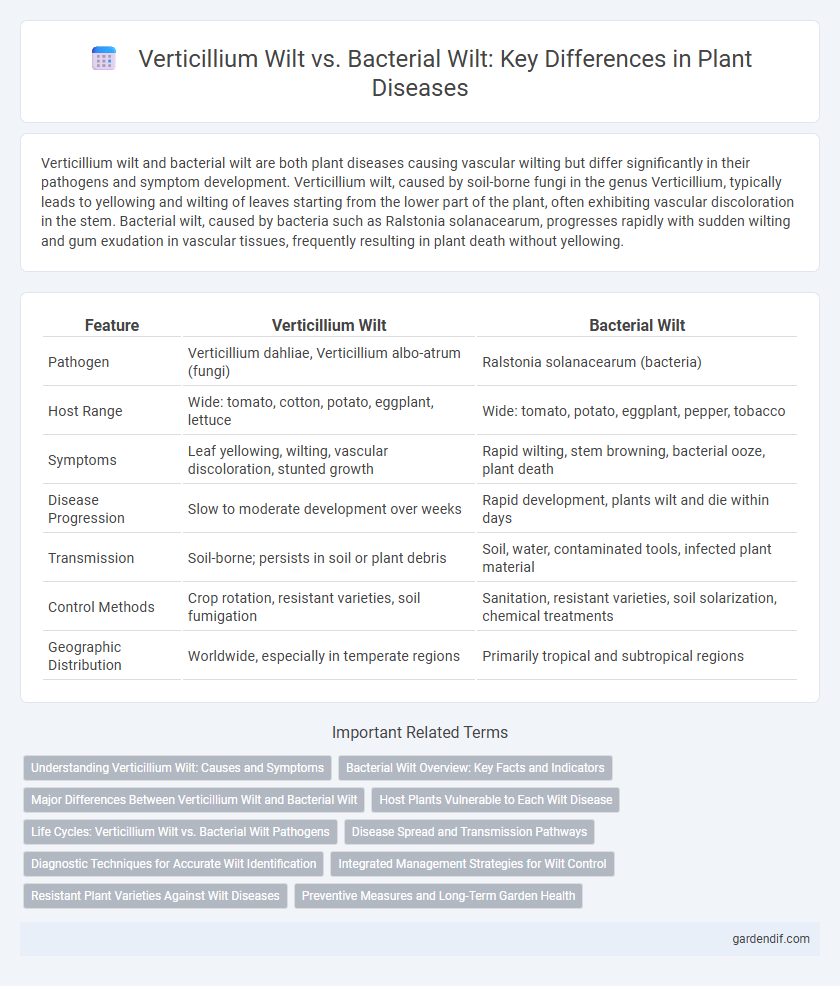
Verticillium Wilt vs Bacterial Wilt Illustration
Verticillium wilt and bacterial wilt are both plant diseases causing vascular wilting but differ significantly in their pathogens and symptom development. Verticillium wilt, caused by soil-borne fungi in the genus Verticillium, typically leads to yellowing and wilting of leaves starting from the lower part of the plant, often exhibiting vascular discoloration in the stem. Bacterial wilt, caused by bacteria such as Ralstonia solanacearum, progresses rapidly with sudden wilting and gum exudation in vascular tissues, frequently resulting in plant death without yellowing.
Table of Comparison
| Feature | Verticillium Wilt | Bacterial Wilt |
|---|---|---|
| Pathogen | Verticillium dahliae, Verticillium albo-atrum (fungi) | Ralstonia solanacearum (bacteria) |
| Host Range | Wide: tomato, cotton, potato, eggplant, lettuce | Wide: tomato, potato, eggplant, pepper, tobacco |
| Symptoms | Leaf yellowing, wilting, vascular discoloration, stunted growth | Rapid wilting, stem browning, bacterial ooze, plant death |
| Disease Progression | Slow to moderate development over weeks | Rapid development, plants wilt and die within days |
| Transmission | Soil-borne; persists in soil or plant debris | Soil, water, contaminated tools, infected plant material |
| Control Methods | Crop rotation, resistant varieties, soil fumigation | Sanitation, resistant varieties, soil solarization, chemical treatments |
| Geographic Distribution | Worldwide, especially in temperate regions | Primarily tropical and subtropical regions |
Understanding Verticillium Wilt: Causes and Symptoms
Verticillium wilt, caused by soil-borne fungi Verticillium dahliae and Verticillium albo-atrum, primarily affects a wide range of plants, leading to systemic infection through root penetration. The disease is characterized by leaf yellowing, wilting, vascular discoloration, and defoliation, significantly impacting plant health and crop yields. Unlike bacterial wilt, Verticillium wilt spreads slower and survives in soil for years, making prevention and early detection critical for effective management.
Bacterial Wilt Overview: Key Facts and Indicators
Bacterial Wilt, caused by Ralstonia solanacearum, primarily affects solanaceous crops such as tomatoes, potatoes, and eggplants, leading to rapid wilting and plant death. Key symptoms include brown discoloration in the vascular tissue, bacterial ooze from cut stems, and stunted growth, distinguishing it from Verticillium Wilt, which is fungal and progresses more slowly. Early detection relies on identifying these vascular symptoms and employing laboratory tests for bacterial identification, critical for effective disease management and crop protection.
Major Differences Between Verticillium Wilt and Bacterial Wilt
Verticillium Wilt, caused by the soil-borne fungus Verticillium dahliae, primarily affects vascular tissues leading to yellowing and wilting of leaves, while Bacterial Wilt, caused by Ralstonia solanacearum, triggers rapid plant collapse due to bacterial blockage in the xylem. Verticillium Wilt symptoms progress slowly with foliar chlorosis and necrosis, whereas Bacterial Wilt often results in sudden wilting and bacterial streaming from cut stems. Control methods differ as Verticillium Wilt requires crop rotation and resistant cultivars, whereas Bacterial Wilt management relies heavily on sanitation and pathogen-specific bactericides.
Host Plants Vulnerable to Each Wilt Disease
Verticillium wilt primarily affects a wide range of host plants including tomatoes, potatoes, cotton, and various tree species such as maples and elms, caused by soil-borne fungi Verticillium dahliae and Verticillium albo-atrum. Bacterial wilt is caused by Ralstonia solanacearum and mainly targets solanaceous crops like tomatoes, potatoes, eggplants, and peppers, as well as some ornamental plants and bananas. Host plant susceptibility varies with environmental conditions and pathogen strain, making crop rotation and resistant varieties crucial for managing both diseases.
Life Cycles: Verticillium Wilt vs. Bacterial Wilt Pathogens
Verticillium wilt is caused by soil-borne fungi Verticillium dahliae and Verticillium albo-atrum, which survive in infected plant debris and soil as microsclerotia, enabling long-term dormancy and infection of new hosts through root penetration. Bacterial wilt, primarily caused by Ralstonia solanacearum, persists in water, infected plant residues, and weed hosts, entering plants via wounds or natural openings and rapidly multiplying in the xylem vessels to block water transport. The fungal life cycle involves slow systemic colonization and microsclerotia formation for persistence, while bacterial wilt exhibits a fast infection cycle with biofilm formation and survival in diverse environments, influencing disease management strategies.
Disease Spread and Transmission Pathways
Verticillium wilt primarily spreads through soil-borne fungal spores that infect plant roots, facilitating transmission via contaminated soil, water, and infected plant debris. Bacterial wilt, caused by various Ralstonia species, transmits mainly through infected seeds, vegetative propagation materials, soil, and insect vectors such as beetles. Both diseases exhibit rapid systemic movement within host plants, but bacterial wilt shows a higher potential for epidemic outbreaks due to insect-mediated dissemination.
Diagnostic Techniques for Accurate Wilt Identification
Diagnostic techniques for Verticillium Wilt primarily include isolating Verticillium dahliae or V. albo-atrum from vascular tissues and using polymerase chain reaction (PCR) assays specific to these fungi. Bacterial Wilt diagnosis relies on isolating Ralstonia solanacearum from plant fluids and employing serological tests such as ELISA for precise detection. Accurate identification integrates molecular diagnostics and culture-based methods, critical for effective disease management in affected crops.
Integrated Management Strategies for Wilt Control
Integrated management strategies for Verticillium Wilt and Bacterial Wilt emphasize crop rotation with resistant varieties and soil solarization to reduce pathogen load. Incorporating organic amendments like compost and maintaining proper irrigation practices minimize plant stress and inhibit pathogen proliferation. Regular monitoring along with the use of biological control agents such as Trichoderma spp. or Bacillus subtilis enhances disease suppression and promotes sustainable wilt control.
Resistant Plant Varieties Against Wilt Diseases
Resistant plant varieties against Verticillium wilt commonly include tomato cultivars such as 'Celebrity' and cotton varieties like 'FiberMax 966' that possess genetic traits limiting fungal colonization. In contrast, resistance to bacterial wilt caused by Ralstonia solanacearum is found in specific crops like eggplants ('Long Purple') and certain potato varieties ('Kennebec'), which inhibit bacterial proliferation and systemic spread. Utilizing these resistant cultivars significantly reduces crop losses through enhanced pathogen defense mechanisms inherent in their genetic makeup.
Preventive Measures and Long-Term Garden Health
Verticillium Wilt prevention involves crop rotation, resistant plant varieties, and maintaining soil health by avoiding infected debris and improving drainage to reduce fungal survival. Bacterial Wilt control focuses on using disease-free seeds, proper sanitation of tools, and eliminating host weeds to minimize bacterial spread. Consistent monitoring and soil solarization support long-term garden health by reducing pathogen reservoirs and promoting a balanced microbiome.
Verticillium Wilt vs Bacterial Wilt Infographic

 gardendif.com
gardendif.com